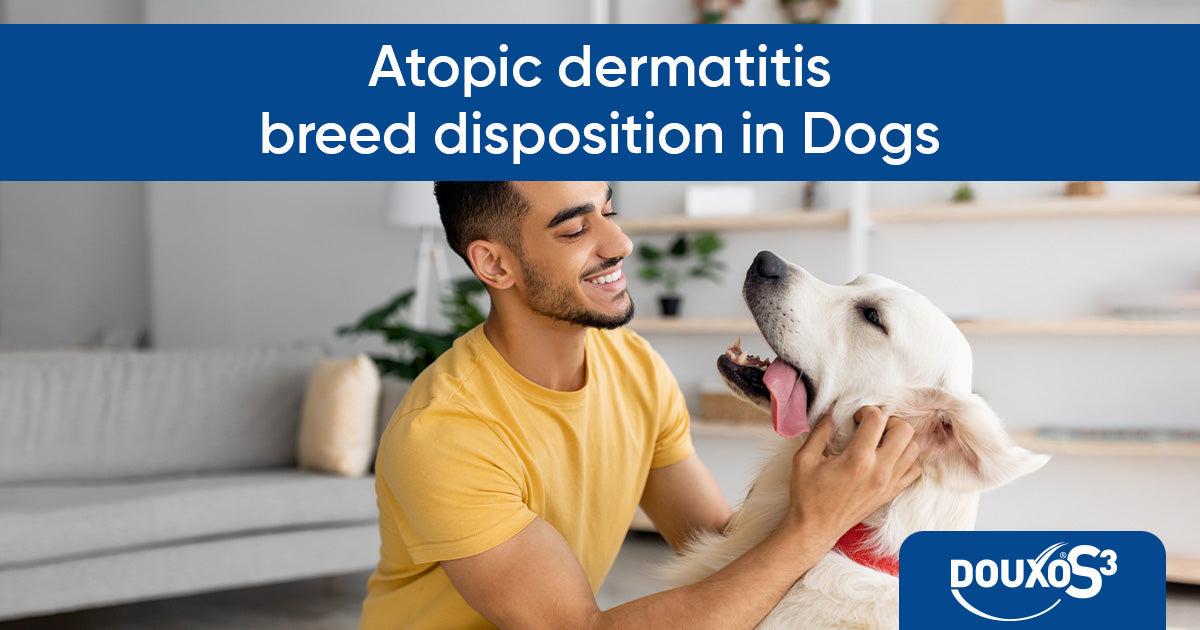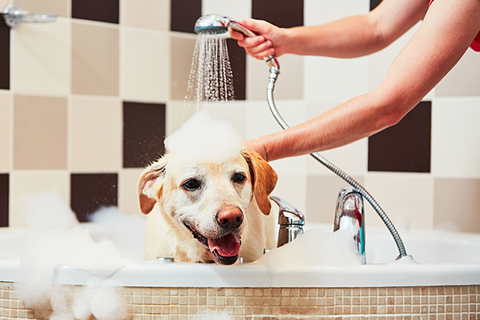
Atopic dermatitis: breed disposition in dogs
Atopic dermatitis is a type of skin disease very commonly seen in dogs. It has a strong genetic component, meaning that some breeds of dog are more likely to be affected, largely due to a defective skin barrier. Management of this lifelong condition involves treatment of uncomfortable symptoms and maintenance of optimal skin condition.
What is atopic dermatitis?
Atopic dermatitis (or ‘atopy’) is a form of allergic skin disease in dogs. It affects around 10% of dogs to various degrees. Allergies occur when the body’s immune system mistakenly reacts to an everyday substance (such as pollen) and launches an inflammatory response.
Symptoms of atopic dermatitis
Canine atopy may present with mild to severe dermatological symptoms.
- Itchy skin (pruritis) – dogs will excessively lick, rub, and scratch at their skin
- Red, sore areas of skin
- Hair loss (alopecia)
- Scabs, crusts, or scaly patches
- A red rash or pimples
- Dark and thickened skin
What causes atopic dermatitis?
Each dog is an individual, and skin allergies can be complex in their predispositions and causes.
It is known that some animals are genetically predisposed to the condition – around half of dogs born to parents with atopic dermatitis go on to develop atopy themselves, and the weakened skin barrier leads to an abnormal immune response. Itching will do the rest, as bacteria that usually live harmlessly in the skin will be overgrown by “bad” bacteria. Breeds with specific physical characteristics (such as skin folds, narrow ear canals...) will also be more vulnerable, as bacteria and yeasts can easily multiply on those places, to complicate the clinical signs.
The skin is made up of three barriers:
- Mechanical: skin cells and fats form a physical barrier, keeping allergens and germs out.
- Immunological: protective cells defend and regulate the body.
- Microbiological: the population of bacteria and yeasts which live harmoniously on the skin surface.
Failure of any of these three barriers may allow allergens to enter and cause an inflammatory response. Predisposed breeds may have various factors which weaken these skin protections, leaving them more likely to develop atopic dermatitis and react to innocuous allergens such as pollens or mould.
The most common substances for dogs to be allergic to include house dust mites, storage mites, pollens, and moulds but food allergies can also be common.
Predisposed breeds
Atopic dermatitis is commonly recognised in certain breeds, but it can occur in any dog.
The most affected breeds include the West Highland White Terrier, Labrador and Golden Retrievers, Bulldogs (English and French), Bull Terriers, Bichon Frise, Shar Pei, Basset Hounds, Boxers, and Boston Terriers. Those animals will have special needs during their lives, as with any other genetic condition, but there is a lot that can be done from the very beginning to make them and their families more comfortable.
How to help
Being aware that atopic dermatitis is a lifelong condition and requires careful management, is a must. It is important to regularly check your dog’s more sensitive skin from an early age, and take measures to maintain optimal skin and coat condition. Playing “vets” is helpful in order to having him/her used to be handled, checking ears, interdigital spaces, and other areas that can be affected in the future, and applying topical products in a regular basis.
The main aims of atopy treatment are to reduce exposure to allergens, and to manage symptoms when exposure is unavoidable. Affected dogs often have a defective skin barrier, and therefore maintaining optimal skin condition can help reduce flare-ups and ease symptoms.
Allergen avoidance
If you know what your dog is allergic to, you may be able to avoid their triggers, or at least reduce them. Taking steps to manage their environment, such as regular cleaning of bedding, avoiding long or freshly cut grasses, wiping down fur after walks, and maintaining a suitable diet can all help, depending on specific allergens.
Modify the immune system
Immunotherapy works by giving the allergic dog a vaccine-type injection of a very diluted form of their specific allergens. This desensitises the immune system, building tolerance and therefore reducing the severity of reactions if the allergen is encountered. However, it may not be effective on its own and requires further management.
Improve the skin barrier
Regular use of suitable, topical products can be a keyway to protect the skin and soothe existing sores and inflammation. Products such as the DOUXO® S3 CALM range can work to target all three skin barriers – mechanical, immunological, and microbiological.
Topical treatments can bring ingredients to exactly where they are needed. Shampoos can clean the skin and fur, removing dirt, debris, parasites, and allergens. Mousses are then applied to allow the ingredients to remain on the skin, soothing and calming irritated skin. If only small areas are affected, the DOUXO® S3 CALM pads can be applied.
Reduce the itch
Inflamed, sore and itchy skin is uncomfortable for dogs, and predisposes to secondary infections. Itching and scratching at the skin causes further trauma and perpetuates the cycle. Medications to reduce inflammation and itching can be used to control these effects.
Summing up
- Atopic dermatitis is a form of allergic skin disease that is very common in dogs
- It is caused by a range of factors which affect the skin barriers, but some breeds are genetically predisposed, including Westies, Labradors, Bulldogs, Shar Pei and Bull Terriers
- Treatment involves reducing exposure, re-training the immune system, medicating the inflammation and itch, and using topical products to soothe the skin and strengthen the skin barriers.
















